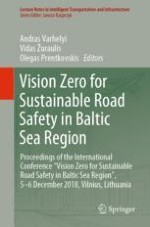2020 | Buch
Vision Zero for Sustainable Road Safety in Baltic Sea Region
Proceedings of the International Conference “Vision Zero for Sustainable Road Safety in Baltic Sea Region”, 5–6 December 2018, Vilnius, Lithuania
herausgegeben von: Andras Varhelyi, Dr. Vidas Žuraulis, Prof. Olegas Prentkovskis
Verlag: Springer International Publishing
Buchreihe : Lecture Notes in Intelligent Transportation and Infrastructure
